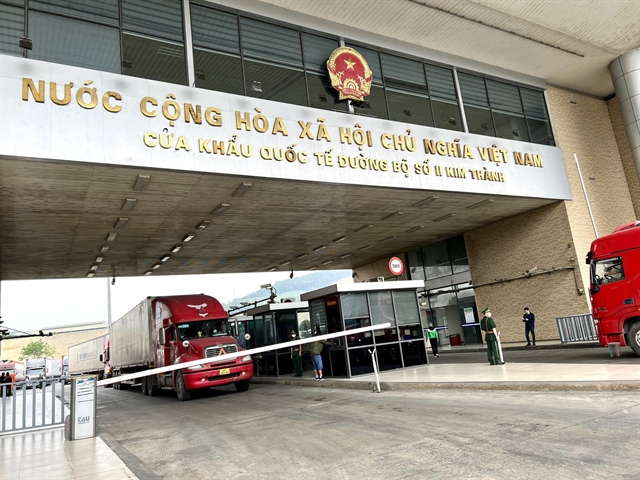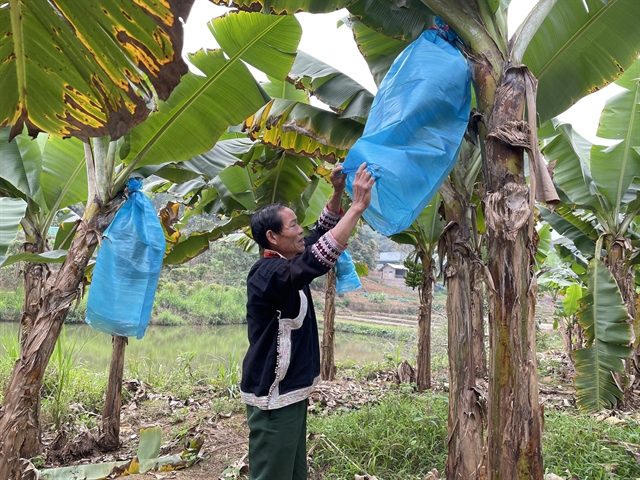 Society
Society

The newfound export surge can be attributed to China's recent modifications in its COVID-19 prevention policies, leaving farmers in anticipation.

|
| Vehicles at Kim Thành International Border Gate in the northern mountainous province Lào Cai.— Photo chinhphu.vn |
HÀ NỘI — The quantity of Vietnamese agricultural goods exported to China via the border gates in the northern mountainous province of Lào Cai has witnessed a significant upswing this year, surpassing figures from previous years.
The newfound export surge can be attributed to China's recent modifications in its COVID-19 prevention policies, leaving farmers in a state of anticipation.
Vàng Kim Sinh, a farmer of Tân Tiến Hamlet, Trịnh Tường Commune, Bát Xát District said he and his neighbours have shifted to plant bananas instead of cassava to earn a living in recent years.
The technique of growing bananas is simple, bringing higher income than growing cassava, he said.
He said since the beginning of this year he has sent several containers of bananas through Kim Thành International Border Gate.
One container contains about 3,300 boxes of bananas, he said.
He said that the price of bananas, which are exported to China, is more than doubled that of bananas he sells to the domestic market.
When China closed its door due to the pandemic, he said that bananas from the commune were only sold domestically with the highest price of VNĐ3,000 (US$0.12) per kg.
Now, he said the bananas had been exported to China’s Yunnan Province with the price over doubled, about VNĐ7,000 ($0.30) per kg.
Statistics from Lào Cai Province’s Customs Department showed that in the first quarter of this year, import and export turnover through local border gates reached nearly US$186 million.
The export turnover reached $92.4 million, about 90.1 per cent higher than last year, while the import turnover reached $93.2 million, about 15 per cent higher than last year.
Agricultural products are still the main exported products, reaching more than $71 million, about 63.2 per cent higher than last year, Chính phủ (Government) News reported.
Agricultural products account for 76.8 per cent of the total export turnover. Main agricultural products include dragon fruit, banana, rambutan, watermelon, cassava and durian.
Creating favourable conditions
Dương Xuân Sinh, deputy director of the provincial Customs Department, said that the department had deployed the electronic customs model and electronic tax collection-and-payment model to assist businesses in saving time and costs in taking customs clearance procedures at border gates.
The department has also maintained good infrastructure to serve the operation of the "priority stream" for agricultural products through a pair of international road border gates of Việt Nam’s Kim Thành and China’s Beishan since June 28, 2019, he said.
Besides, he said that the border guard force had arranged more staff to regulate traffic at the border gates, instructing drivers to stop and park at the right places.
He said about 300 vehicles carrying imported and exported goods run through Lào Cai International Border Gate daily.
"We have restored all activities on the border areas to facilitate economic development and trade at the border gate," said Lieutenant Colonel Nguyễn Trọng Tuệ of Lào Cai International Border Gate’s Border Guard Station.
In addition, the border guard force has also created favourable conditions for entry and exit for people, vehicles and goods through the Kim Thành International Border Gate based on the principle of strictly implementing the agreement on border gates and regulations on the management of the land border gate between Việt Nam and China.

|
| Vàng Kim Sinh, a farmer of Tân Tiến Hamlet, Trịnh Tường Commune, Bát Xát District at his banana garden. — Photo chinhphu.vn |
Enhancing connectivity
China has been an important export market for some agricultural and aquatic products of Việt Nam, and it is the largest export market for Vietnamese vegetables, fruits, cassava and products from rubber. After the US and Japan, it is the third largest export market for Vietnamese seafood products.
Some commodity groups such as seafood, fruit, and coffee of Việt Nam are among the ten largest exporters to China.
During the official visit to China by General Secretary Nguyễn Phú Trọng late 2022, the two sides already signed several Protocols on the export of agricultural products.
China officially reopened border gates on January 8 this year after it changed COVID-19 prevention policies, offering an opportunity for many types agricultural and aquatic products of Việt Nam to export to China.
Tô Vạn Quang, China’s Đông Đằng Investment Industry Company Limited, said that this year, the company plans to buy 35,000 tonnes of durian, including 15,000 tonnes from Việt Nam.
Besides, the company also demands to buy 120,000 tonnes of purple sweet potatoes and seafood such as catfish and pit fish.
With great help from large State-owned enterprises in China and competent authorities in Việt Nam, the company is promoting the establishment of the Việt Nam Seafood Trading Centre in Fangchenggang City in Guangxi Province, he said.
Fangchenggang City’s administration has started the construction of two large-scale seafood cold storages. The first cold storage has an area of 600 acres (2.4 million sq.m) with the capacity to store 200,000 tonnes of seafood. He said the second cold storage has an area of 1,000 acres (over 4 million sq.m) with a storage capacity of 600,000 tonnes of seafood.
Therefore, he said Vietnamese seafood could enter the Chinese market in large quantities very quickly in the future.
He added that the centre in Fangchenggang City is also a place where buyers and sellers can directly meet and transact.
Vũ Bá Phú, director of Việt Nam Trade Promotion Agency under the Ministry of Industry and Trade, said that trade promotion activities with the Chinese market have been active since the first months of this year.
He said this year's export promotion activities for the Chinese market focus on supporting Vietnamese businesses and localities to export their products through official channels to China.
Việt Nam has a northern border with China with a length of over 1,449 km. Cross-border import and export activities in seven northern border mountainous provinces, with seven international border gates, six bilateral border gates, and 21 sub-border gates, are getting busier and busier. — VNS




